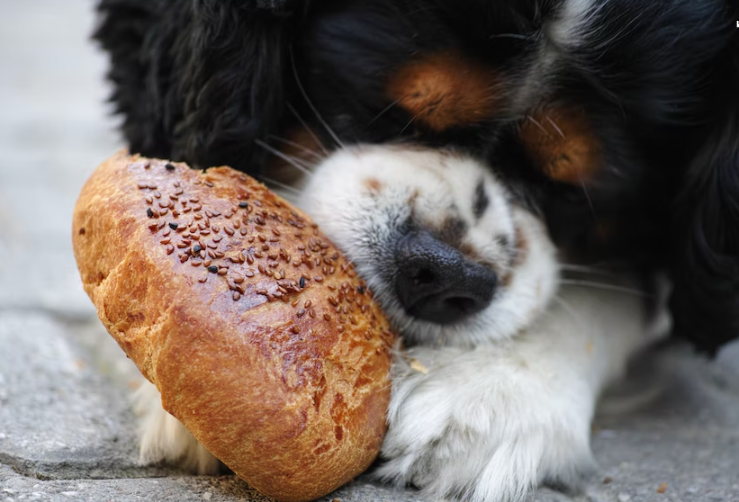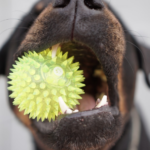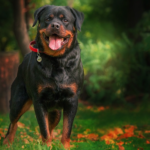Rottweilers are big dogs that need a well-balanced diet to stay healthy and full of energy. A good diet is important for your Rottweiler’s overall health and can help prevent health problems like obesity, joint problems, and digestive problems. This article will tell you everything you need to know about the Rottweiler dog food chart.
First, let’s take a look at what Rottweilers need to eat. For their muscles to grow and stay strong, these dogs need to eat a lot of protein in their food. They also need a lot of fat to keep their coats healthy and give them energy. Rottweilers also need a moderate amount of carbohydrates for energy and fiber to help their digestive system.
Look for a high-quality brand that meets AAFCO (Association of American Feed Control Officials) standards when choosing dog food for your Rottweiler. AAFCO makes the rules for pet food in the U.S. and makes sure that the food you give your dog has all the nutrients it needs to stay healthy.
Rottweilers should eat a diet that includes high-quality proteins like beef, chicken, or fish. The majority of their food should be made up of these proteins, and they should be listed first on the label. Rottweilers also need a lot of healthy fats like chicken fat or fish oil, in addition to protein.
When it comes to carbs, you should look for dog food that has complex carbs like brown rice or whole grains. These carbs take longer to break down, so they keep giving you energy for a long time. Simple carbs, like corn or wheat, should be avoided because they can cause blood sugar to rise quickly.
Rottweilers also need to eat a lot of fiber to keep their digestive system healthy. This can be found in carrots, green beans, and peas, among other vegetables. Also, it’s important to make sure your dog gets enough vitamins and minerals from the food they eat. You can get these from fruits and vegetables or from a good dog food with added vitamins and minerals.
When it comes to how much food to give your Rottweiler, it’s important to follow the serving size suggested on the dog food label. This will depend on your dog’s age, size, and level of activity. It’s also important to keep an eye on your dog’s weight and change its food as needed to keep it from getting too fat.
Related articles:
- Full details about Rottweiler diet Rottweiler food chart
- Rottweiler breed specific dog food: what you need to know
- Nourishing Your Rottweiler: The Importance of a Healthy Diet
Hierarchy of dog food
The different kinds or levels of quality of dog food are called “categories” or “levels” of dog food. The order is based on what ingredients are used and how they are processed. Premium dog food is at the top of the hierarchy. It is made with high-quality ingredients and has all the nutrients a dog needs. High-quality dog food is the next step up. It may have ingredients that aren’t as good, but it still gives your dog good nutrition. Mid-range dog food is made with ingredients of average quality and may include fillers or by-products. Economy or budget dog food is at the bottom of the list. It is made with low-quality ingredients and doesn’t have all the nutrients a dog needs.
It’s important to know how dog food is ranked so you can choose what to feed your dog in a smart way. Premium and high-quality dog food cost more, but in the long run, your dog’s health will benefit from the higher-quality ingredients and better nutrition. On the other hand, cheap dog food might be cheaper, but it might not have all the nutrients your dog needs and might have ingredients that are bad for their health.
When choosing dog food, you should think about your dog’s age, breed, size, level of activity, and any health problems he or she may have. It’s also important to read the labels and choose a dog food that meets AAFCO (Association of American Feed Control Officials) standards for complete and balanced nutrition.
What are the 3 types of dog food?
Dry, wet, and raw food are the three main kinds of dog food.
- The most common kind of dog food is dry food, which is also called “kibble.” It is easy to use, easy to store and lasts for a long time.
- Wet food, which is also called canned food, has more water than dry food, which makes it more appealing to dogs who like a more moist diet.
- Raw food, which is also called a “raw diet,” is based on the idea that dogs should eat food that is similar to what their wild ancestors would have eaten. This kind of food usually includes raw meat, bones, organs, and fruits and vegetables.
It’s important to think about your dog’s individual needs and tastes when choosing a type of dog food. A balanced diet can also be made up of many different kinds of food. It’s also important to choose a high-quality brand that meets AAFCO (Association of American Feed Control Officials) standards for complete and balanced nutrition.
What is the healthiest food to feed your Rottweiler?
The best food to feed a Rottweiler is one that is well-balanced and full of all the nutrients it needs. A Rottweiler should eat high-quality, premium dog food made from whole meats, fruits, and vegetables because it has all the vitamins and nutrients it needs. Avoid dog food with low-quality ingredients and fillers, like by-products and artificial preservatives.
When choosing a food for your Rottweiler, it’s important to think about their age, breed, size, and level of activity. A vet can help you figure out what the best food is for your Rottweiler based on how they eat and what they need.
In addition to a well-balanced diet, it’s important to make sure your Rottweiler gets a lot of exercises, clean water, and regular veterinary checkups to keep their health and well-being in good shape.
Summary
A Rottweiler dog food chart should have options for high-protein, high-fat diets that give the dog everything it needs to stay healthy. Based on the ingredients and ways the food is made, dog food ranges from “premium” to “economy.” Dry (kibble), wet (canned), and raw are the three main kinds of dog food. A high-quality, premium dog food made from whole meats, fruits, and vegetables that meets AAFCO standards for balanced nutrition is the best choice for a Rottweiler. A Rottweiler’s overall health is also affected by how often it gets exercise, how clean its water is, and how often it sees a vet.







